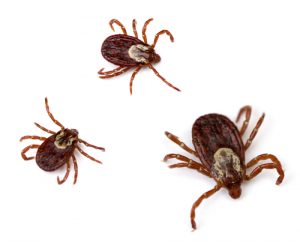Brown Dog Ticks
By Chris Williams on July 6, 2011.
Q. A friend who has several dogs and an outdoor kennel offered to take our two dogs while we were on vacation. Not too long after we were back and the dogs were home, we had an outbreak of what looked like tiny mites. They were crawling all over everything. Later I found out from another friend that the woman who boarded the dogs has been having a problem with brown dog ticks! After doing some Internet research, I think maybe that’s what we’re dealing with. I’m really angry with this woman for not disclosing that she had ticks, but in the meantime, what do we do?
A. Based on that information and although it’s unusual, you may have an infestation of brown dog ticks. The brown dog tick is not common around homes in our area. In fact, it is pretty much confined to kennels where it tends to crawl upwards and hides in cracks in kennel roofs or in ceilings or porches. It can’t survive the winter outdoors in our area, but in heated buildings, it can be found at any time of year.
Ticks are not mites, but two indoor mite pests (clover mites and bird mites) do look a lot like immature brown dog ticks so you’ll need to make sure you’re not really dealing with mites instead. The brown dog tick is about 1/8 inch, slightly smaller than the more common American dog tick. The adult tick is a solid reddish-brown in color without any of the white markings of other ticks. After feeding on blood, the female becomes enlarged, bean-shaped and a grayish-blue color. What you’re seeing now though are the young larval or nymphal ticks that have hatched out.
 Unlike many of our wood ticks where the young ticks and adult ticks feed on different animals, all three stages of the brown dog tick feed only on dogs. For this reason, an infestation can be ongoing indoors as long as there is a dog present. The adult ticks are most often found on the ears and between the toes of dogs, and the immature ticks are found in the long hair on the dog’s back. Fortunately, this tick rarely attaches to people and doesn’t spread any diseases to humans, but it can spread diseases to dogs.
Unlike many of our wood ticks where the young ticks and adult ticks feed on different animals, all three stages of the brown dog tick feed only on dogs. For this reason, an infestation can be ongoing indoors as long as there is a dog present. The adult ticks are most often found on the ears and between the toes of dogs, and the immature ticks are found in the long hair on the dog’s back. Fortunately, this tick rarely attaches to people and doesn’t spread any diseases to humans, but it can spread diseases to dogs.
After feeding on dog blood for a few days, the female brown dog tick drops off of the dog to lay thousands of eggs in cracks and crevices, under carpeting, along baseboards, and in dog bedding. The very tiny larval ticks that hatch are commonly called seed ticks and are barely visible. They crawl up any vertical surface and can be found on the lower portions of walls or clustered behind curtains or moldings where they wait for a dog to pass by.
The control of brown dog ticks is a multi-part process. First, you’ll need to have your vet treat your dogs to kill any ticks on the animals. Secondly, you’ll want to have a pest control company treat your home at the same time to kill the many seed ticks. In fact, you will probably need more than one treatment since the ticks can remain hidden in crevices for a long time between feedings. Finally, wash or replace pet bedding that may contain ticks or eggs. Frequent vacuuming will also help remove ticks.